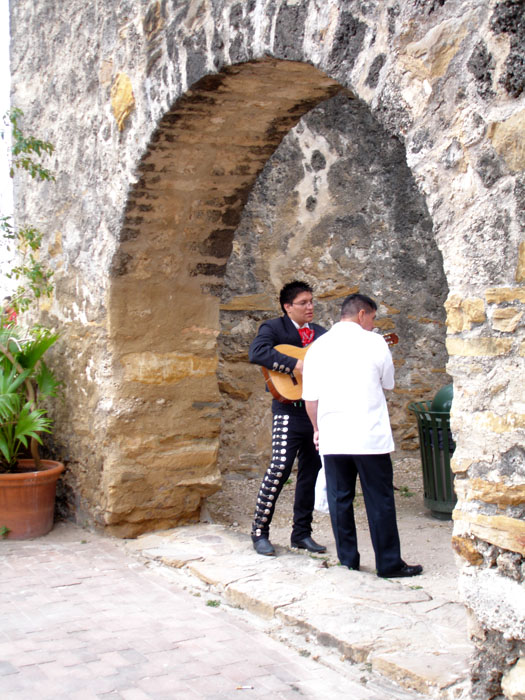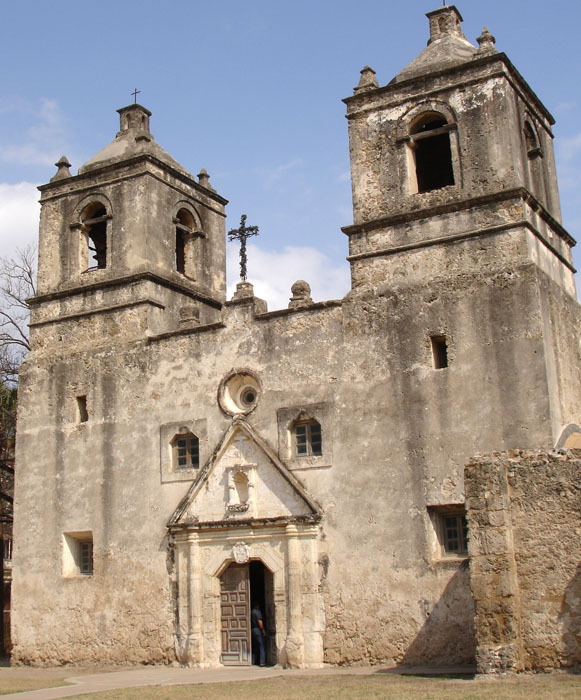
“The chain of missions established along the San Antonio River in the 18th century is a reminder of one of Spain’s most successful attempts to extend its dominion northward from New Spain (present-day Mexico). Collectively they form the largest concentration of Catholic missions in North America,” (San Antonio Missions pamphlet, National Park Service – NPS).
Although the Spanish originally came to the New World looking for wealth, as did most others, once those dreams faded they focused their efforts on spreading the Catholic faith among the native Indians. “the mission was the vanguard of the spiritual conversion of the Indians. . . For the Indians the missions offered sanctuary from their enemies,” (NPS).
“The American Indians who lived in the San Antonio missions came from a number of hunting and gathering bands known collectively as Coahuiltecans (kwa-weel-tekens),” (NPS)
The missions flourished between 1747 and 1775. “After 70 years the need for the missions diminished due to the effects of European diseases, acculturation, and intermarriage. By 1824 the San Antonio missions were secularized,” (NPS)
The Mission San Antonio de Valero, more well known as the Alamo, was the first mission on the San Antonio River. You can see read more about it in an earlier post, Three days in San Antonio — part 2: Remember the Alamo. It is now a State Historic Site under the care of the Daughters of the Republic of Texas and has been turned into a historic park in downtown San Antonio.

The Mission Trail runs along the San Antonio River, south of downtown where travelers can still see four remaining missions that look nearly the same in their remote locations as they did during the height of their activity.

Mark and I drove to the southern end of the Mission Trail and worked our way back north. Mission San Francisco de la Espada is the southernmost mission, although its roots lie in east Texas where it was founded in 1690. “Along with several others it served as a buffer against French encroachment from Louisiana,” (NPS). After relocating several times because of illness, floods, fires, enemies and limited supplies, Mission San Francisco de la Espada was finally established here along the San Antonio River in 1731.

The missions typically consisted of a church, convent, workshop, granary, soldiers’ barracks, and indian quarters, all surrounded by a stone wall. The living quarters for the people of the mission were built along the inside wall. In the above photograph you can see the size of the living quarters where the wall has broken away.
“The missions functioned primarily as religious centers and training grounds for the rudiments of Spanish citizenship. Indians were taugh obedience to the Crown along with the vocational skills needed for economic self-sufficiency,” (NPS).

Espada began the process of secularization, or transformation to a church-based community, in 1794 . The land was divided among the 15 families who remained at the time. The supplies and equipment were shared. Disaster struck in 1826 when a band of Comanches raided the corn fields and killed livestock, and a kitchen fire destroyed most of the buildings. The chapel survived. Even so, people continued to make their home here. (NPS).

“The Indian neophytes’ days were highly structured. At sunrise, bells called them to morning Mass . . . Daily training and tasks were accomplished by the timing of the mission bells ‘which clang out three times a day . . . startling in the still country air.'” (NPS)


Today a small community of mission descendants continue to worship here.

“Espada’s ongoing legacy lies in the blending of Spanish and American Indian lifeways on this sacred ground, creating a new people and culture,” (NPS).

Mission San Juan Capistrano lies just a little north of Espada. We were touring on a Sunday morning and we arrived there just in time to see the priest and servers entering the chapel for Mass. Although it was nice to witness the present-day use of this historic buildings, the downside to touring on a Sunday was that we were unable to go inside of most of the missions while Mass was being celebrated.
While walking around the exterior of the chapel, we saw this statue of a woman.
Like Espada, Mission San Juan was originally established in East Texas and then was moved here in 1731. Mission San Juan is located in rich farmland and became a regional supplier of agricultural produce. “The San Antonio missions were self-sufficient, and they supported area settlements and the nearby presidio (fort). In good times they traded surplus goods to others,” (NPS).

Relative to the first two missions our third stop, San Jose y San Miguel de Aguayo, was a massive and decorative structure.

We could immediately see why San Jose has the reputation of being “Queen of the Missions.”
We actually came upon the mission from the back and first saw this beautiful arched walkway.
You can see how this structured once held two levels. The massive stone walls of the mission reflect its defensive role. “The Indians’ struggle for survival against European disease and raiding Lipan Apaches led them to the missions and to forfeit their culture. Everything changed for them: diet, clothing, religion, culture—even their names. They were required to learn two new languages, Latin and Spanish, as well as new vocations,” (NPS).
We worked our way around to the side of the chapel that holds the legendary Rose Window, or Rosa’s Window.

The window “demonstrates the high craftsmanship of the artisans who worked on the missions. . . (and is ) known as the premier example of Spanish Colonial ornamentation in the United States,” (NPS).
The front facade is another example of beautiful craftsmanship. Because of its size, and model organization, San Jose was a social center during this time period, (NPS).

This small section of remaining fresco leads one to imagine how magnificent the interior of the chapel might have been in its early days.

We timed our tour and our visit to Mission San Jose to coincide with the Mariachi Mass that is regularly celebrated there.
Mark and I have attended Mass in various locations from a small gathering in the woods or on a retreat, to inside magnificent cathedrals in large cities here or abroad. But this Mass in what, by our standards, was a small intimate chapel in a relatively remote area of Texas with the lively music provided by the Mariachi musicians was truly a unique experience.

Our last stop on the Mission Trail was the mission of Nuestra Senora de la Purisima Concepcion. It is closest to the city of San Antonio and lies just outside the intersection of routes 10 with 37. We approached the mission from outside the side wall.

The two towers you see beyond the wall are the front of the chapel.

Like the other missions, Concepcion was transferred here from East Texas in 1731. “The church looks essentially the same as it did in the mid-1700s. . .,” (NPS).
For some reason arched walkways have always appealed to me. It looks inviting, doesn’t it?
This stairway reminds me of ruins we visited in Ireland, Italy, and even Japan. I think it has to do with the stone, and the narrow passage.

Again, the remains of frescoes inside the buildings lead one to imagine the glory of past days.
This is a large well in front of Concepcion.

If you ever find yourself in San Antonio, set aside some time to visit these relics of the past and keepers of current culture. Whether you are interested in architecture, the settling of this country, the attempts to acculturate or assimilate native peoples, or the role of the Catholic church in colonizing America, the missions in San Antonio are well worth the visit.
For more information visit:
National Park Service – San Antonio Missions
VisitSanAntonio.com
For other posts about San Antonio, see San Antonio, Texas.












I went with my father at the end of a summer. San Antonio is such a sprawling city but I’m glad the downtown area has remained pretty quaint. Too many super malls and track homes going in on the outskirts though.
I think you’ll find those super malls everywhere, but you’re right about San Antonio. The downtown area, especially the King William area is still nice and quaint.
Beautiful, thank you so much for sharing this trip.
Thank you for stopping by.
Thanks for taking us with you on your journey, Christine. Nice photos!
You’re welcome.
Love this architecture. Spanish contribution to the settlement and founding of the United States is generally absent and certainly underplayed in public schools and history curriculum. Spain had over 400 missions/towns in what became the SW quadrant of the US 100 years before the Pilgrims came.
That’s interesting, Carl. I never really thought about it much. (Probably because you’re right and I was never really taught it.) We noticed all the Spanish missions and influence along the California coast too.
Fascinating, Christine. I would never have guessed there was so much to see in San Antonio. I’m with you–love the archways! Fabulous post, my friend.
Hugs,
Kathy
Thanks, Kathy. I have to admit, when Mark suggested we go to San Antonio, I thought, “Why?” I’m glad we did.
Very interesting historical facts and ancient architecture. Thank you for sharing. Blessings to you, Christine…
Blessings to you too, Carol Ann.
Thank you for this. Fabulous photos. This is one place I”d love to roam!
I think you would love it.
Loved my time and visit in San Antonio Mission.. you took me around it beautifully as I looked at the buildings and stairways and floors and statues… amazing place.. Thank you for sharing it with us ~Sue.. xxxx
I’m glad you enjoyed it. Thanks for stopping by.
Gorgeous photography. I’m always fascinating by the profoundly complex story of the West- a story that really doesn’t reflect itself in the Western- and I’ve been familiar with the Missions in San Antonio from a distance. I have to see them for myself.
And you’re not the only one who likes arched walkways. They seem very peaceful.
You do have to see them for yourself. (But don’t go in the heat of summer, we were there in March and that was pleasant enough.)
Thanks for sharing! 🙂 very beautiful!
Thanks for stopping by.
Finally found some time to spend looking at your pictures. I love this old architecture. Thanks for sharing!
Thanks for stopping by. The missions were very cool.
Superb pictures Christine. I’m writing an historical novel set during the Texas Revolution and been meaning to get to San Antonio to follow the mission trail northward starting at Espada. Thank you for taking me on that journey until I can do it myself!
Thanks for stopping by, Karina. I always enjoy it when someone comments on one of my older posts and causes me to revisit it. That was a wonderful trip. I hope you are able to go sometime soon. I like historical fiction. Why did you pick that time period?
I wish you well with your project.
Thank you! My family played a part in the revolution and I wanted to write their story. It’s now evolved into something completely different and with my tendency toward perfection I have to get the little things right or it will put off my readers.
Thanks again for your trip!